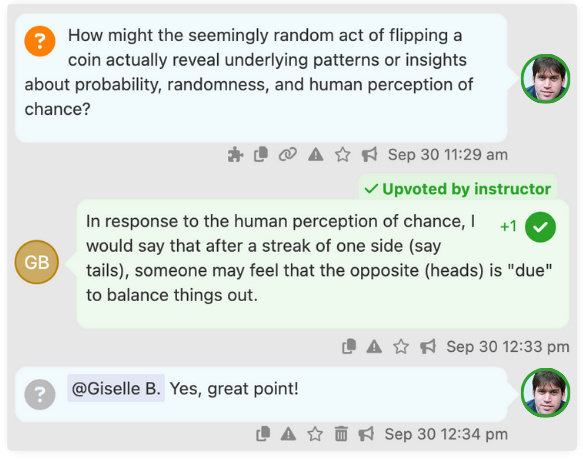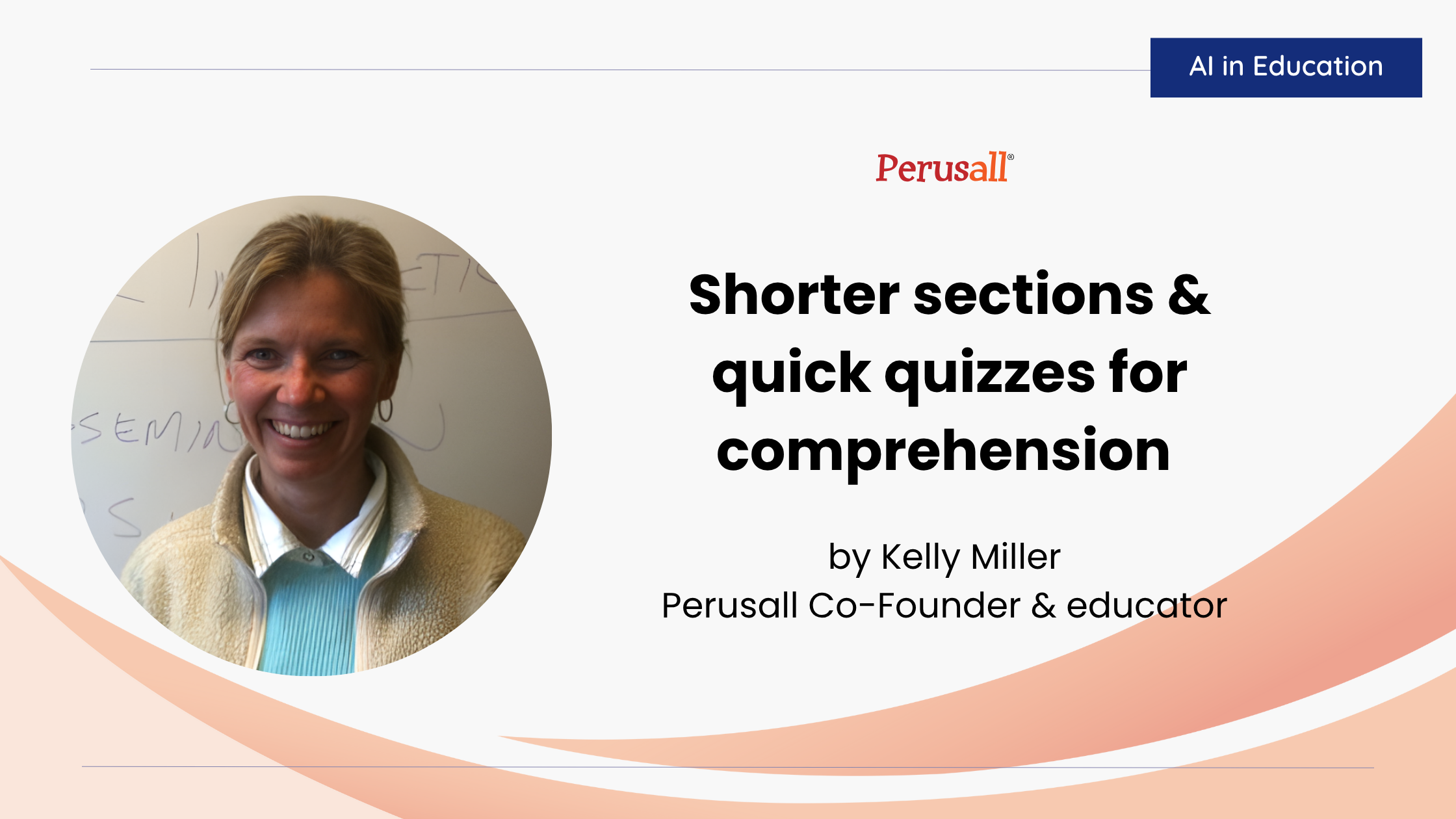Generative AI has introduced both challenges and opportunities for teaching and learning, and we are seeing its growing impact on our learning communities. In this blog series, Perusall’s Co-founders and fellow educators share their best practices to promote healthy AI usage and intrinsic motivation in their own Perusall courses.
.png)
Brian Lukoff is the Co-founder and Chief Technology Officer of Perusall and an assistant professor of instruction at The University of Texas at Austin's McCombs School of Business. He shares some effective ways you can encourage authentic student engagement in your Perusall courses.
Make reading essential and accessible
Students engage more authentically when readings are manageable, meaningful, and clearly tied to learning goals. If students believe that the content you are assigning is interesting and relevant — both for their success in the course and for their academic or career goals — then they will be more likely to see Perusall as a tool for their learning, rather than as a task to complete. When that happens, students become intrinsically motivated to engage with the content and with each other, because they become invested in the ideas of the course and in what others have to say about it.
In contrast, if the reading isn’t well-targeted to students’ needs — if there is too much of it for students to really absorb in the time allotted, or if it isn’t appropriate for their current level — then they are more likely to view it as busy work. I make a big deal to my students on the first day of class that I never assign busy work. I’m only going to assign content to them if I truly think it will impact their learning, and over the years, I’ve tried to refine my approach by better tailoring the content to my students.
It can be helpful to highlight why actively reading (or watching or listening to) the course content really matters for their learning. I emphasize to students that learning is not a “one-shot” operation; rather, they’ll ultimately benefit (e.g., on exams!) from approaching and returning to the content multiple times in different ways — first, before class with Perusall; then in class with a mix of explanation and practice; and finally after class with homework.
Finally, the “no busy work” framing also provides a way to talk about responsible AI use. I can’t (and don’t want to) police student use of AI outside of class, but I can try to convince them that they should be extremely thoughtful and careful about how they use AI for out-of-class work. Using AI as a supplement to help them understand tricky concepts and techniques can be valuable, but they shouldn’t outsource their thinking or writing to AI — doing so turns what would be a good use of their time into busy work!
Vary assignments and assessment approaches
.png)
While the real magic I’m after is building students’ intrinsic interest in the course content, many students will still benefit from a light “nudge” to participate. Making Perusall participation part of your course grade can be an effective way to get students in the door: you can set up “scoring templates” in Perusall to apply your desired grading criteria and weights for measuring student engagement and provide students with immediate feedback. However, be careful not to overemphasize the grading. I consider the Perusall part of my students’ grades to be motivational rather than a measurement of their learning, so I set it up to be a small percentage of the overall course grade with a fairly lenient scoring template that makes it easy for students to get full credit as long as they make a reasonable effort. I tell students not to worry about their grade (and to come and talk with me if they are putting in an effort but not getting 100%!) so that they focus on the content and conversation rather than worry about points.
Because it’s easy to create multipart assignments in Perusall, you can also keep the experience fresh by mixing assignment types and deliverables without making things complicated for students to participate in. For example, you might intersperse short quizzes to assess basic comprehension or solicit feedback from students, breaking up a long reading with activities in between sections. Or consider integrating videos, podcasts, journal articles, or web content to supplement readings from a textbook.
Stay present and foster motivation

Your (and/or your teaching assistants’) presence inside Perusall can help reinforce to students that you value the course readings (or videos or podcasts) and consider it to be an important part of students’ learning experience. Different instructors have different styles for whether and how they choose to participate in the discussions, and different approaches can be successful. For example, some instructors like to guide discussion or focus attention on specific parts of the content by adding in prompts for students to respond to — you can even require students to respond to a prompt independently before they’ll see other students’ responses to the prompt. I like to upvote good comments (for example, well-written responses to questions from other students) to give students positive feedback and encourage thoughtful responses.
It can be tricky to decide if and when to jump in on a conversation students are having. I am often tempted to correct a misconception or to provide a straightforward answer to a question, but I usually prefer to give other students an opportunity to respond — I don’t want to stifle discussion by conditioning students to wait for me to chime in with “the right answer”! Besides, all of this discussion is taking place before class, so I’ll have an opportunity to reframe discussion and address misconceptions or unresolved questions during class. (I will sometimes post answers to questions after class, if the question never got a response and wasn’t something we had the opportunity to discuss in class.)
Speaking of class, it can be very valuable to bring the Perusall discussion into the classroom. Sometimes this takes the form of trying to address (or go deeper on) a particular point in class because it came up in the reading — the Confusion Report in Perusall can be a good way of summarizing student questions since I can rarely read through all of my students’ questions before class! Another powerful opportunity to connect Perusall to class time arises when a student makes a particularly interesting point or states a question in a really nice way — when this happens, I can quote it on a slide and use it as the jumping-off point for an explanation or activity. Besides being motivating for the student who wrote it, making that connection helps convince the rest of the class that I’m paying attention to what they are saying in Perusall and that I’ll tailor class time to their specific needs.
Brian Lukoff is the Co-founder and Chief Technology Officer of Perusall and an assistant professor of instruction in the Department of Information, Risk, and Operations Management at The University of Texas at Austin’s McCombs School of Business. He teaches courses on statistics.
He earned his Ph.D. in educational measurement and technology from the Stanford University School of Education, and he completed a postdoctoral fellowship in technology and education at Harvard University’s School of Engineering and Applied Sciences. Brian also holds an M.S. in statistics from Stanford University and a B.A. in mathematics from Cornell University.
Stay tuned for upcoming posts in the series by Kelly Miller, Eric Mazur, and Gary King!
Want to try out Perusall? Join us at the Perusall Academy, our free guided training series, to get started with your course.



.png)




